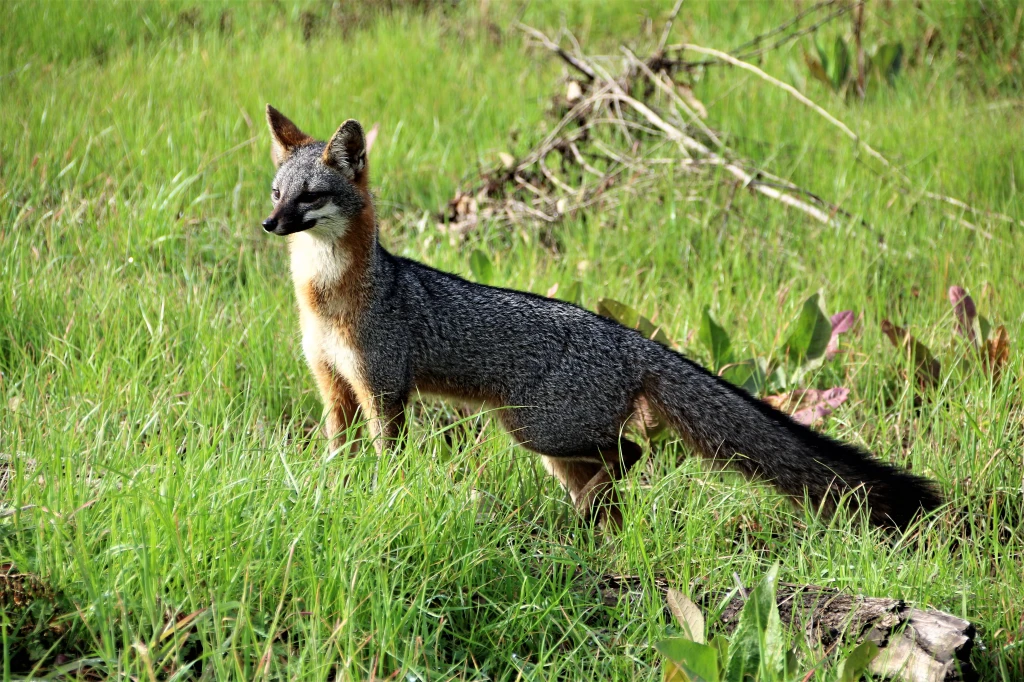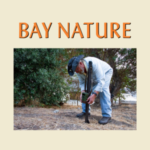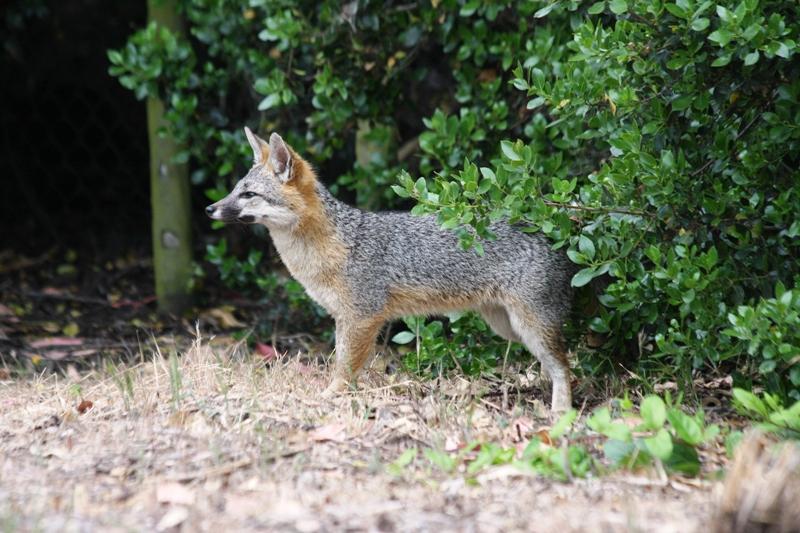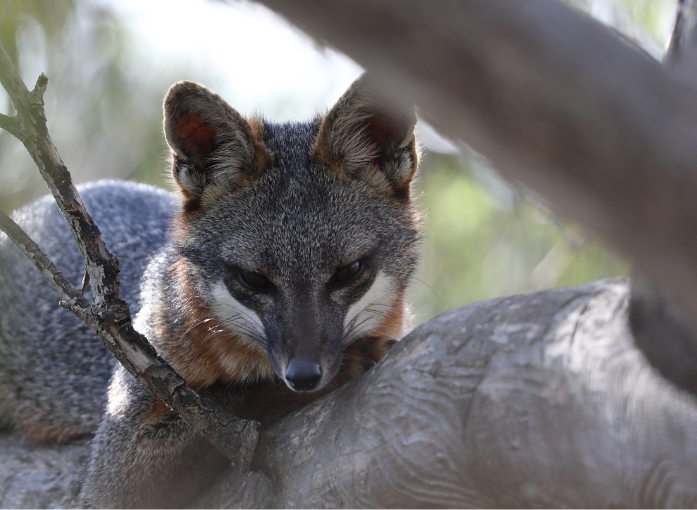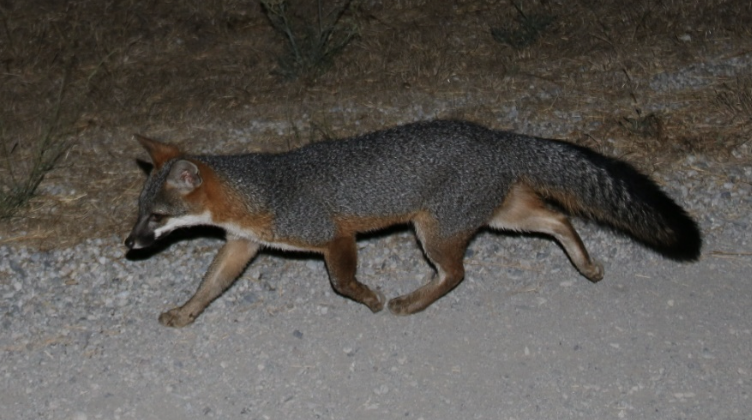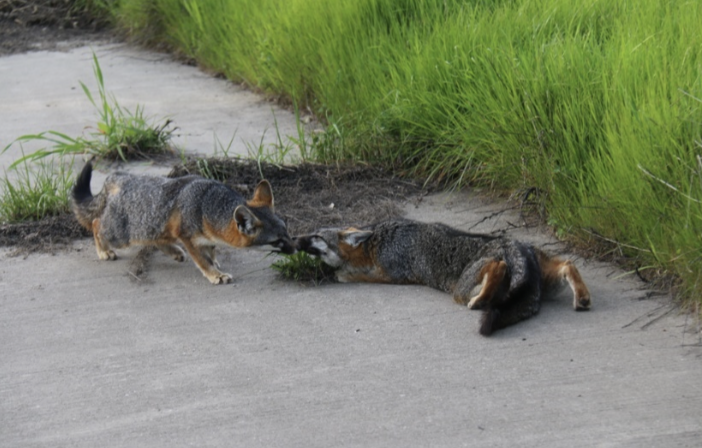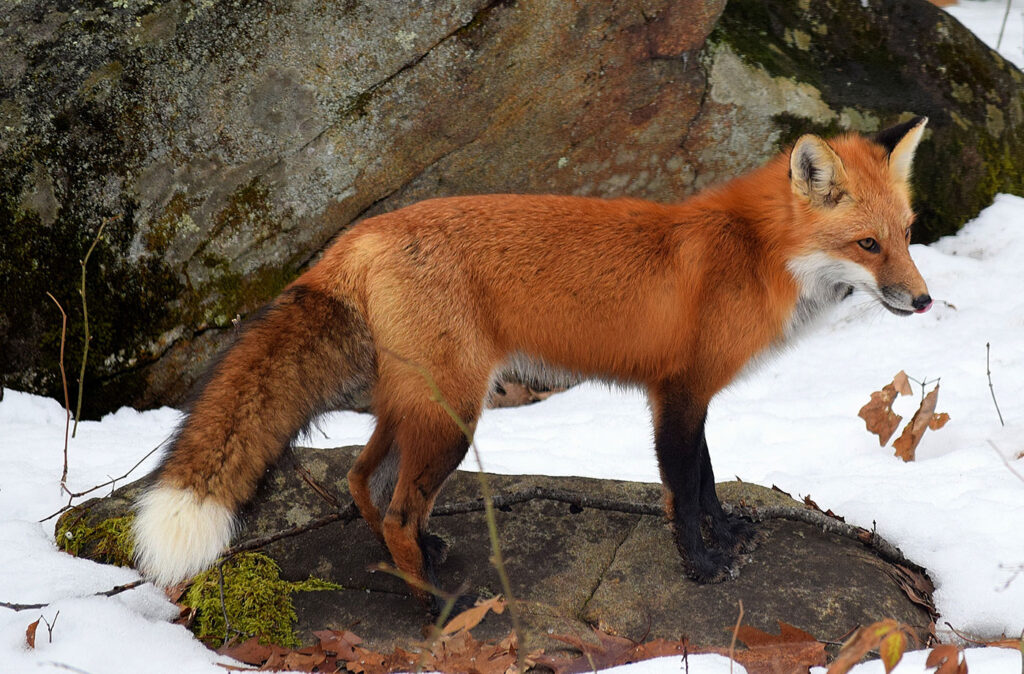by William C. Leikam
President, CEO & Co-founder, Urban Wildlife Research Project
What I’ve Learned About Gray Fox Behavior
Part 3 – Food and the Origins
of the Gray Fox Hierarchy
Beyond nutrition, food plays an important role within the gray fox family’s structure. During my initial ethological studies in Central California on the behavior of the gray fox (Urocyon cinereoargenteus townsendi) among their many behaviors, I noted that the foxes kept any food that they may have captured to themselves. Gray foxes do not share food. Before the family’s pups learn how to effectively hunt, catch and consume their own prey, the adult pair hunt for and bring back prey to their natal den. The gray fox family’s hierarchy is established through conflict over food.
 I first saw the hierarchy forming on one of the videos from our trail cameras. At first all the five pups chased and played around the fennel stalks and into the weeds. Chase and play, it’s happy fun. One of the adults brought in a jack rabbit and dropped it in a small clearing nearby. Instantly, the pup’s play morphed into greed. The pups scrambled to take possession of this rabbit. One of the pups raced for the prize but before it could take charge, two others took hold and a screaming, shrieking tug-of-war ensued. The remaining two pups worked to take hold too. Finally, after a crazy mix of pups battling for exclusive possession, two of them pulled the hindquarters away from the others. They charged up and over a large polyethylene pipe, one tugging at one end of the rabbit’s leg and the other tugging at the other one for all of its might. The rabbit’s hindquarters tore in two and both pups dashed off into the dark, leaving the other three with nothing to eat. In the end, that pup, the one that regularly gets the most food, becomes the alpha pup of the family. All the rest of them fill a lower niche in the family’s culture.
I first saw the hierarchy forming on one of the videos from our trail cameras. At first all the five pups chased and played around the fennel stalks and into the weeds. Chase and play, it’s happy fun. One of the adults brought in a jack rabbit and dropped it in a small clearing nearby. Instantly, the pup’s play morphed into greed. The pups scrambled to take possession of this rabbit. One of the pups raced for the prize but before it could take charge, two others took hold and a screaming, shrieking tug-of-war ensued. The remaining two pups worked to take hold too. Finally, after a crazy mix of pups battling for exclusive possession, two of them pulled the hindquarters away from the others. They charged up and over a large polyethylene pipe, one tugging at one end of the rabbit’s leg and the other tugging at the other one for all of its might. The rabbit’s hindquarters tore in two and both pups dashed off into the dark, leaving the other three with nothing to eat. In the end, that pup, the one that regularly gets the most food, becomes the alpha pup of the family. All the rest of them fill a lower niche in the family’s culture.
One Saturday morning, as Greg, one of the cofounders and I made the rounds of our trail cameras we came upon the alpha pup Fearless. Her three siblings were nearby. I saw one up in a coyote bush, just up the hill and the others were lying about, eyeing Fearless as she ate. They waited for her to walk away and leave the rest of that squirrel’s carcass to them. By that time in their lives, each of the pups knew its place in the hierarchy; all the way down to the omega, the last gray fox named Shy. She lay off to the left of the other pups. She might get nothing from that food chain and so, in Shy’s case, she learned to be patient. Fearless took one last bite of that squirrel. She walked off toward Harbor Hill. One by one the other gray fox pups came for the left-overs.
Similarly, on another occasion, freelance journalist Tom and I stood at the edge of Fox Hollow Hill with four young pups chasing in and out of the nearby brush and climbing out on a fallen eucalyptus branch. These four pups were Mama Bold and her mate Gray’s litter. As Tom took several photographs, I noticed one of the adults trotting across the road toward the hill, carrying something in its mouth. I called Tom’s attention to what I thought would be an interesting situation, yet I had no idea what was about to transpire in but less than a minute. Through the tall grass Gray came up onto the hill no more than 10 feet away. He dropped a dead squirrel in the midst of his racing, dashing pups. Instantly, one snatched up the squirrel and ran for the bushes, but before it could get undercover, another took hold. They fought, ripping at the rodent. A third pup snatched up a hind leg and ran. The remaining pup hung in the background as if simply waiting for the ruckus to settle down.
From multiple observations over several consecutive years, it appeared as if the strongest and/or the most aggressive pup emerged as the dominant or alpha pup. This part of the gray fox culture is aimed at maximum survival of the fittest and it is not gender biased.
Grey Fox General Health
There are no gray foxes in the Palo Alto Baylands Nature Preserve. However, there is a family of three red foxes that have moved into the territory. Presently, we are monitoring them.
Gray Fox, Baylands Goals
Within the permit that allows the Urban Wildlife Research Project to conduct its study of the behavior of the gray fox at the Palo Alto Baylands Nature Preserve, the objectives covered are:
- Monitoring of urban gray fox Denning sites in Palo Alto Baylands.
This is being accomplished during the period when the gray foxes use a den site. It is one of the prime locations for gathering most of the behavioral data of the litter and for adults alike.
- Assessment of status and population trends of Baylands urban gray foxes.
Since January 2019 a pair of resident gray foxes have claimed territory at the Palo Alto Baylands Nature Preserve.
- Identification of habitat features that promote the presence of urban gray foxes.
The Urban Wildlife Research Project is working on a project to remove the concrete from Matadero Creek that will create linkages and corridors between the Santa Cruz Mountain Range and the Palo Alto baylands..
- Assessment of reproductive success and identification of factors that promote successful reproduction.
Open the pinch-point along Matadero Creek by developing thickets that link one area to another, instead of the present island-like habitat.
- Identification and assessment of possible dispersal travel routes.
Dispersal routes move between the Palo Alto Baylands Nature Preserve and the Shoreline region over in Mountain View. In a north-westerly direction the dispersal corridors run just behind the homes bordering the marshlands.
What's Happening at UWRP?
On Friday March 28, 2025, Bill gave a video PowerPoint talk to Ms. Pauline Shu’s 3 rd grade class at El Granada Elementary School. Bill said, “In many ways those third graders ask better questions than adults.”
Be on the lookout for Bill being booked to give another talk over at Meta (Facebook). We’re working on it.
The Urban Wildlife Research Project will be present at Safari West for Earth Day on April 26th. Why not drop by our booth and say hello.
If you or your organization would like to have Bill aka the Fox Guy present one of his four PowerPoint presentations:
1. A Year with the Urban Gray Fox – MOST POPULAR
2. Human Development, Sixth Mass Extinction & Gray Foxes – An historical look at how we got to our present place in history.
3. Gray Fox Cognition – What & How Gray Foxes Perceive – This is an attempt to get inside the mind of a gray fox
4. Corridors & Connections – Sustaining the Health of Our Wildlife – The title says it all
Contact us here https://urbanwildliferesearchproject.org/contact/ and let us know.
Videos and Documentaries

My journey to the University of Zurich, Switzerland, Triggered By Motion

Bill’s book The Road to Fox Hollow can be purchased directly from Bill for a mere $20.00. Just email him through the Contact form on the Urban Wildlife Research Project’s website, leave your email address and he will get back to you. Or you can contact the publisher Di Angelo Publications .
A video documentary about Bill’s work with the foxes and produced at Stanford University by Syler Peralta-Ramos.
What happens when an opossum and a red fox meet in the night?
In contrast to two other raccoon discipline videos, this one is rather mild.
Gray Fox Playfulness “Hugging” Behaviors.
See the violence of Discipline Raccoon Style.
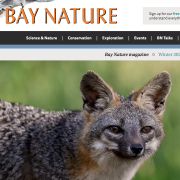
“How to be a Fox” The article about Bill and his ethological approach to his study of the gray fox is online here. Many are calling this a major article in the wildlife press.
Be Sure to check out our YouTube Channel for some incredible wildlife videos.

